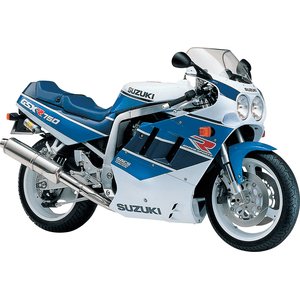Suzuki GSX-R 750 (1992-1995): The Lightweight Legend Revisited
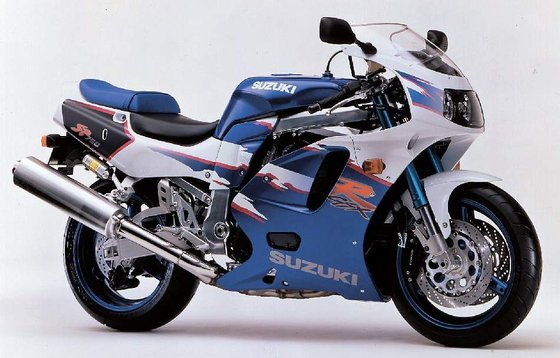
Introduction
When Suzuki unleashed the GSX-R 750 between 1992 and 1995, it wasn’t just updating a motorcycle—it was refining a philosophy. This era marked a pivotal chapter in the GSX-R saga, blending the raw, unapologetic aggression of early ’80s sportbikes with the precision engineering of the modern era. Known internally as the "WN" (1992), "WP" (1993), "WR" (1994), and "WS" (1995) models, this generation bridged the gap between analog thrills and the dawn of liquid-cooled sophistication. For riders today, it remains a benchmark of how a 750cc inline-four should sound, feel, and dominate both street and track.
Let’s dissect what made this generation iconic, how it stacks up against rivals, and why it’s still a favorite for enthusiasts hunting for vintage performance with timeless character.
Design & Chassis: The Art of Subtraction

The 1992-1995 GSX-R 750 was a masterclass in weight reduction without compromise. Starting at 208 kg (458.6 lbs) dry in 1992, Suzuki shaved nearly 9 kg (19.8 lbs) by 1994 through meticulous engineering: magnesium engine covers, hollow transmission shafts, and a redesigned aluminum frame that boxed critical sections for rigidity. The 43mm inverted Showa forks (introduced in 1994) replaced conventional telescopic units, cutting unsprung weight and improving steering response.
The chassis geometry—24.5° rake and 94mm (3.7 in) trail—struck a balance between razor-sharp turn-in and high-speed stability. Riders praised the "planted" mid-corner feel, aided by a braced swingarm and 180/55ZR17 rear tire (wider than the 1992 model’s 170/60). The fairing, though bulkier than today’s minimalist designs, reduced drag with a flush-mounted headlight and wind-tunnel-tested contours.
Key Takeaway: This generation’s chassis wasn’t just lightweight—it was intelligent. Every gram shed translated to quicker direction changes, whether threading through canyon bends or diving into Willow Springs’ Turn 8 at 130 mph.
Engine & Performance: The Screaming Symphony
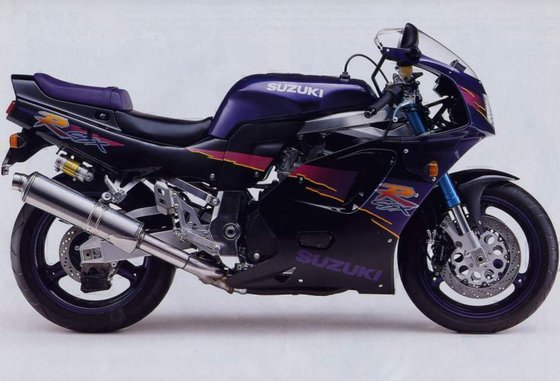
At its heart lay a 749cc liquid-cooled inline-four (a first for the GSX-R in 1992), delivering 112–118 hp at 10,500–11,500 rpm. Unlike its peaky predecessors, this engine combined SCAI (Suzuki Condensed Air Intake) with 38mm Mikuni BST carburetors (TRM40s in later models) for a broader powerband. The numbers tell part of the story:
- 0–100 km/h (0–62 mph): 3.2 seconds
- Top Speed: 246–257 km/h (153–160 mph)
- Quarter Mile: 10.7–11.16 seconds @ 199–206 km/h (124–128 mph)
But the real magic was in the delivery. Below 7,000 rpm, the GSX-R felt docile, almost polite. Crack the throttle past 8,000 rpm, though, and the engine transformed into a snarling beast, pulling relentlessly to its 12,500 rpm redline. The 6-speed transmission, hailed as the "slickest in the business," rewarded aggressive shifts with rifle-bolt precision.
Rider’s Note: The 1994-1995 models traded outright top speed for midrange grunt, thanks to revised cam profiles and a 4-2-1 exhaust. It’s a trade-off that made street riding less frantic without sacrificing track potency.
Riding Experience: Brutal, Rewarding, Uncompromising
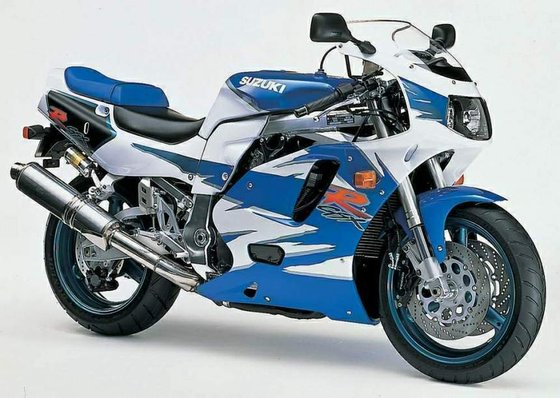
Swing a leg over the GSX-R, and the message is clear: this isn’t a bike for half-measures. The 795mm (31.3 in) seat height and rearset pegs force a committed riding position—elbows bent, chest against the tank. At low speeds, the cockpit feels cramped (especially for riders over 5’10”), but once the pace quickens, the ergonomics click into focus.
Handling: The Showa suspension, adjustable for preload and damping, was firm yet communicative. On smooth asphalt, the GSX-R carved lines with surgical precision. Over bumps, the rear "Full Floater" shock absorbed imperfections while keeping the tire glued to the tarmac.
Braking: Tokico/Nissin 6-piston calipers clamped onto 310mm discs, offering stoppie-inducing power. Fade was rare, even after repeated hard laps, thanks to ceramic-backed pads introduced in 1994.
The “Aha!” Moment: On a winding backroad, the GSX-R’s lightweight frame and telepathic front end inspire confidence. It’s a bike that demands you push harder, trusting its ability to pivot on a dime and rocket out of corners.
Competition: How the GSX-R Stacked Up
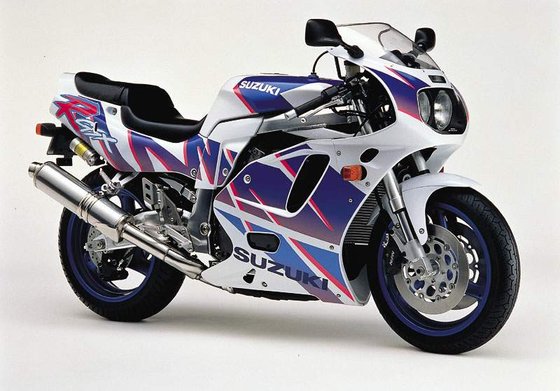
Yamaha YZF750 (1993-1995)
- Pros: Silky-smooth 20-valve engine with EXUP valve, sublime cornering manners.
- Cons: 15 hp deficit above 10,000 rpm, vague gearbox feel.
- Verdict: The YZF was the better all-rounder, but the GSX-R dominated in raw speed and track readiness.
Honda CBR900RR Fireblade (1992-1995)
- Pros: Lighter (208 kg vs. 199 kg), explosive 893cc engine.
- Cons: Less stable at extreme speeds, softer suspension.
- Verdict: The Fireblade redefined hyperbikes, but the GSX-R remained the purist’s choice for track days.
Kawasaki ZX-7R (1993-1996)
- Pros: Bulletproof reliability, comfier ergonomics.
- Cons: Heavier (215 kg), sluggish low-end response.
- Verdict: A touring-friendly alternative, but outgunned by the Suzuki’s race-bred DNA.
Takeaway: The GSX-R’s blend of top-end power, razor-sharp handling, and brawny aesthetics made it the go-to for riders prioritizing adrenaline over comfort.
Maintenance: Keeping the Legend Alive
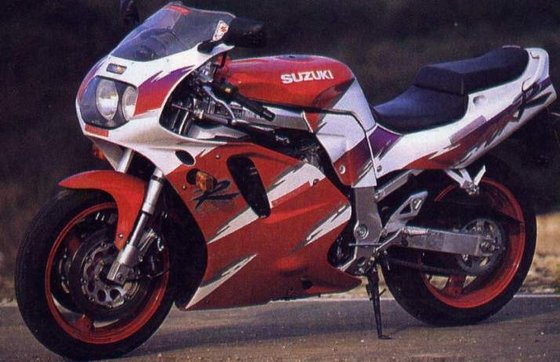
Owning a 1990s GSX-R requires vigilance but pays dividends in longevity. Key considerations:
- Valve Adjustments: Every 7,500 km (4,660 miles). Cold clearances:
- Intake: 0.10–0.20 mm (0.004–0.008 in)
-
Exhaust: 0.20–0.30 mm (0.008–0.012 in)
-
Oil Changes: 3.3L (3.5 qts) of 10W-40 synthetic every 5,000 km (3,100 miles). Don’t skip the filter!
-
Carb Tuning: The TRM40/Mikuni BST38SS carburetors demand synchronization every 10,000 km. A clogged pilot jet can neuter midrange response.
-
Cooling System: Flush coolant every 2 years using ethylene glycol. Watch for leaks at the aluminum water pump (upgrade to a billet unit available).
-
Chain & Sprockets: The #530 O-ring chain (15/42 gearing) lasts 20,000 km with regular lubrication.
Pro Tip: Upgrade to braided brake lines and sintered pads for sharper lever feel—a nod to modern safety without losing vintage charm.
Conclusion: The Last True Analog Superbike
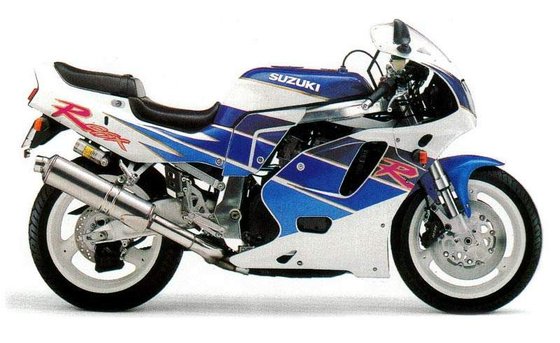
The 1992–1995 GSX-R 750 isn’t just a motorcycle; it’s a time capsule of an era when horsepower wars were fought with carburetors and steel frames. It’s unrefined, demanding, and occasionally brutal—but that’s the point. In a world of rider aids and electronic nannies, this GSX-R reminds us that speed should be earned, not engineered.
Whether you’re hunting for a track-day weapon or a classic to restore, this generation delivers. And when it’s time to rebuild, remember: MOTOPARTS.store has the OEM-spec components and performance upgrades to keep your GSX-R screaming for another 30 years.
Ride hard, rev higher, and let the inline-four sing.


Specifications sheet
| Engine | |
|---|---|
| Stroke: | Four-stroke |
| Max power: | 88 kW | 118.0 hp |
| Max torque: | 80 Nm |
| Fuel system: | 4 x TRM40 carburetors (1994-1995) / 4 x Mikuni BST38SS carburetors (1992-1993) |
| Lubrication: | Wet sump |
| Max power @: | 11500 rpm |
| Displacement: | 749 ccm |
| Max torque @: | 10000 rpm |
| Configuration: | Inline |
| Cooling system: | Liquid-cooled with oil-cooled oil cooler |
| Compression ratio: | 11.8:1 |
| Number of cylinders: | 4 |
| Dimensions | |
|---|---|
| Wheelbase: | 1440 mm (56.7 in) |
| Dry weight: | 199 |
| Wet weight: | 229.5 |
| Seat height: | 795 mm (31.3 in) |
| Overall width: | 730 mm (28.7 in) |
| Overall height: | 1135 mm (44.7 in) |
| Overall length: | 2095 mm (82.5 in) |
| Fuel tank capacity: | 21 L (5.5 US gal) |
| Drivetrain | |
|---|---|
| Final drive: | chain |
| Gear ratios: | 1st 2.87 / 2nd 2.06 / 3rd 1.65 / 4th 1.43 / 5th 1.26 / 6th 1.12:1 |
| Chain length: | 108 |
| Transmission: | 6-speed constant mesh |
| Rear sprocket: | 42 |
| Front sprocket: | 15 |
| Maintenance | |
|---|---|
| Rear tire: | 180/55 z-17 (1994-1995) / 170/60 z-17 (1992-1993) |
| Engine oil: | 10W40 |
| Front tire: | 120/70 z-17 |
| Brake fluid: | DOT 4 |
| Spark plugs: | NGK CR9EK (1992-1993) / NGK CR9E (1994-1995) |
| Spark plug gap: | 0.6–0.7 mm |
| Coolant capacity: | 2.55 |
| Forks oil capacity: | 1.2 |
| Engine oil capacity: | 3.3 |
| Engine oil change interval: | Every 5000 km or 2 years |
| Valve clearance (intake, cold): | 0.10–0.20 mm |
| Valve clearance check interval: | 24,000 km (15,000 mi) |
| Valve clearance (exhaust, cold): | 0.20–0.30 mm |
| Recommended tire pressure (rear): | 2.5 bar (36 psi) solo, 2.8 bar (41 psi) with passenger |
| Recommended tire pressure (front): | 2.3 bar (33 psi) |
| Additional Notes | |
|---|---|
| Idle speed: | 1200 ± 100 rpm |
| Steering damper: | Hydraulic, non-adjustable (1994-1995) |
| Notable features: | SCAI air intake system, magnesium engine covers, aluminum water pump |
| Chassis and Suspension | |
|---|---|
| Frame: | 5-sided aluminum pipe frame with sand-casted steering head |
| Rear brakes: | Single 280 mm disc (1994-1995) / 240 mm disc (1992-1993), 2-piston caliper |
| Front brakes: | 2 x 310 mm discs, 6-piston Nissin calipers (1994-1995) / 4-piston calipers (1992-1993) |
| Rear suspension: | Full floater monoshock, preload, compression, and rebound adjustable |
| Front suspension: | Showa 43 mm USD forks (1994-1995) / 41 mm USD forks (1992-1993), preload, compression, and rebound adjustable |
| Front wheel travel: | 120 mm (4.7 in) |



